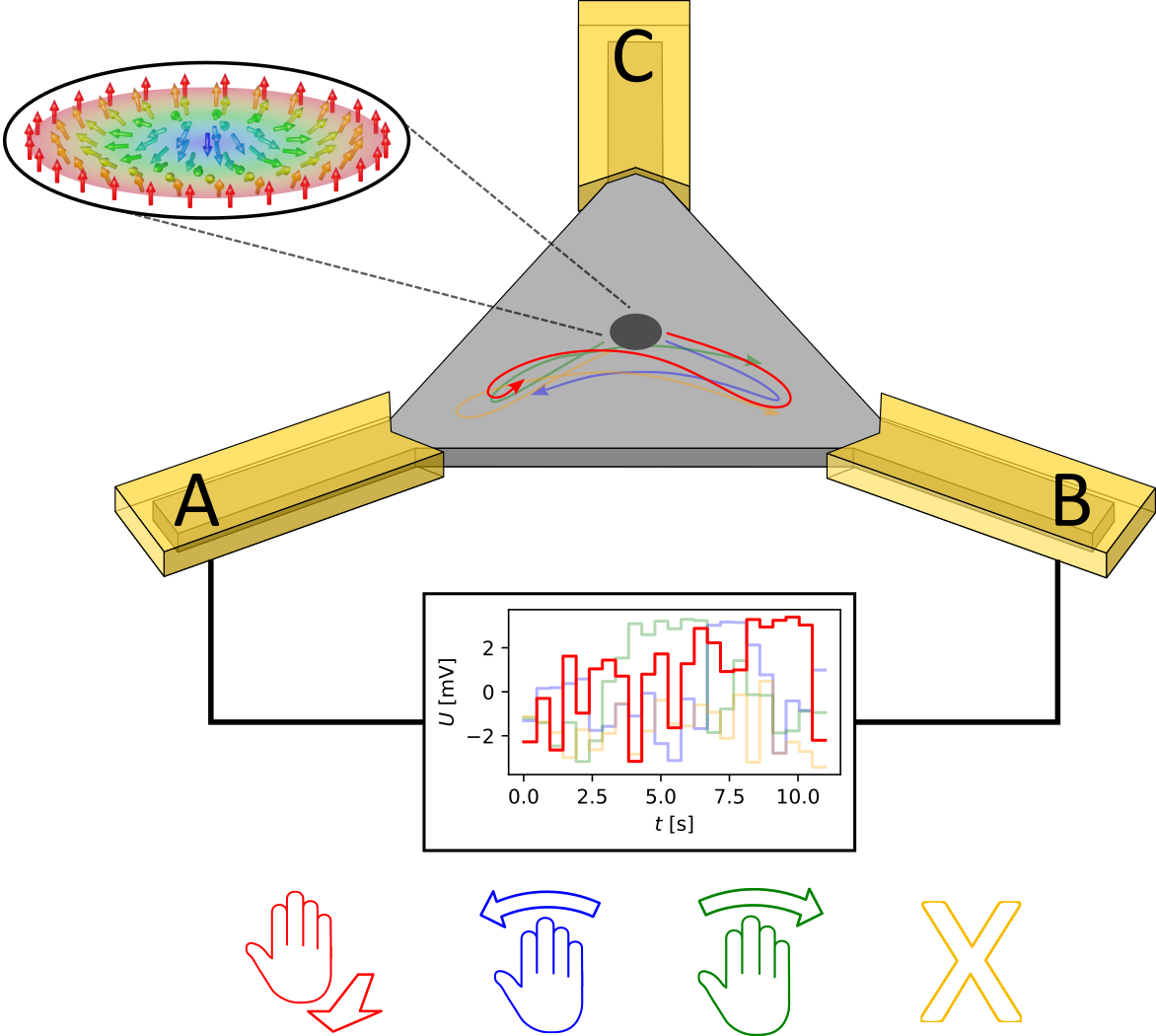Reviewed by Danielle Ellis, B.Sc.Sep 17 2024
Scientists at Johannes Gutenberg University Mainz (JGU) improved Brownian reservoir computing by capturing hand movements and feeding them into a system. This setup utilized skyrmions to identify specific gestures, advancing the technology's capabilities in motion recognition. The study has been published in Nature Communications.
 Schematic representation of the dynamic Brownian reservoir computer: An electric voltage is employed to move a skyrmion on the triangular thin film. The colored rings represent different hand gestures. The motions performed by the skyrmion allow for the interpretation of the type of hand gesture detected by the system. Image Credit: Grischa Beneke
Schematic representation of the dynamic Brownian reservoir computer: An electric voltage is employed to move a skyrmion on the triangular thin film. The colored rings represent different hand gestures. The motions performed by the skyrmion allow for the interpretation of the type of hand gesture detected by the system. Image Credit: Grischa Beneke
We were impressed to see that our hardware approach and concept worked so well – and even better than energy-intensive software solutions that employ neural networks.
Grischa Beneke, Institute of Physics, Johannes Gutenberg University Mainz
Beneke was able to show that Brownian reservoir computing can recognize basic hand gestures with a relatively high degree of precision, working with other experimental and theoretical physicists.
Reservoir Computing Requires No Training Efforts and Reduces Energy Consumption
Artificial neural networks are similar to reservoir computing systems. One advantage is that neural networks do not require a lot of training, which lowers overall energy usage.
“All we have to do is train a simple output mechanism to map the result,” explained Beneke.
The specifics of the computing procedures are still unknown and unimportant. The system is comparable to a pond where stones have been thrown, causing the surface to have an intricate wave pattern. The system's output mechanism gives information about the initial input, much like the waves indicate the quantity and location of stones thrown.
The researchers explain how two Infineon Technologies radar sensors are used to record basic hand gestures like swiping left or right using Range-Doppler radar. After that, the radar data is transformed into the appropriate voltages and fed into the reservoir, which, in this instance, is made up of a multilayered thin-film stack made of different materials and shaped like a triangle with contacts at each corner. The voltage is provided by two of the contacts, which move the skyrmion inside the triangle.
In reaction to the supplied signals, we detect complex motions. These movements of the skyrmion enable us to deduce the movements that the radar system has recorded.
Grischa Beneke, Institute of Physics, Johannes Gutenberg University Mainz
Chiral magnetic whirls known as skyrmions are thought to hold great potential for application in unconventional computing devices as well as novel data storage devices as information carriers.
Skyrmions are really astonishing. We first regarded them only as candidates for data storage but they also have great potential for applications in computing combined with sensor systems.
Mathias Kläui, Professor and Research Supervisor, Johannes Gutenberg University Mainz
Comparing Brownian reservoir computing results with software-based methods reveals similar or even better accuracy in gesture recognition. The mix of reservoir computing and Brownian concepts lets skyrmions move freely, as local magnetic differences affect them less. Unlike their usual behavior, skyrmions can now move with very low currents, greatly improving energy efficiency compared to software methods. The Doppler radar data and the reservoir's internal dynamics work on similar timescales, allowing direct input of sensor data into the reservoir. The system's timescales can be adjusted to solve various other problems.
“We find that the radar data of different hand gestures is detected in our hardware reservoir with a fidelity that is at least as good as a state-of-the-art software-based neural network approach,” the researchers concluded in the study.
Beneke states that additional advancements in the read-out procedure, which presently employs a magneto-optical Kerr-effect (MOKE) microscope, ought to be feasible. The system's overall size may be decreased by using a magnetic tunnel junction in its place. The reservoir's capacity is already being illustrated by simulating the signals produced by a magnetic tunnel junction.
Successful International Collaboration to be Continued
The JGU research team led by Professor Mathias Kläui announced the first advancements in Brownian reservoir computing back in November 2022. Together with Radboud University in Nijmegen, the Netherlands, Professor Johan Mentink and his team developed a prototype system that integrated these two computing techniques.
Infineon Technologies, a chip manufacturer, was also involved in the research. The German Research Foundation (DFG)-funded Transregional Collaborative Research Center 173 "Spin+X – Spin in its collective environment," JGU's Top-level Research Area "TopDyn – Dynamics and Topology," and the Carl Zeiss Foundation-funded Emergent Algorithmic Intelligence project offered additional support.
Additionally, the study was supported by the European Union under the NIMFEIA project and the 3D MAGiC ERC Synergy Grant project. According to Professor Mathias Kläui, Brownian reservoir computing will probably continue to advance quickly in the future, especially with the support of business partners who can offer actual use cases.
Journal Reference:
Beneke, G., et al. (2024) Gesture recognition with Brownian reservoir computing using geometrically confined skyrmion dynamics. Nature Communications. doi.org/10.1038/s41467-024-52345-y